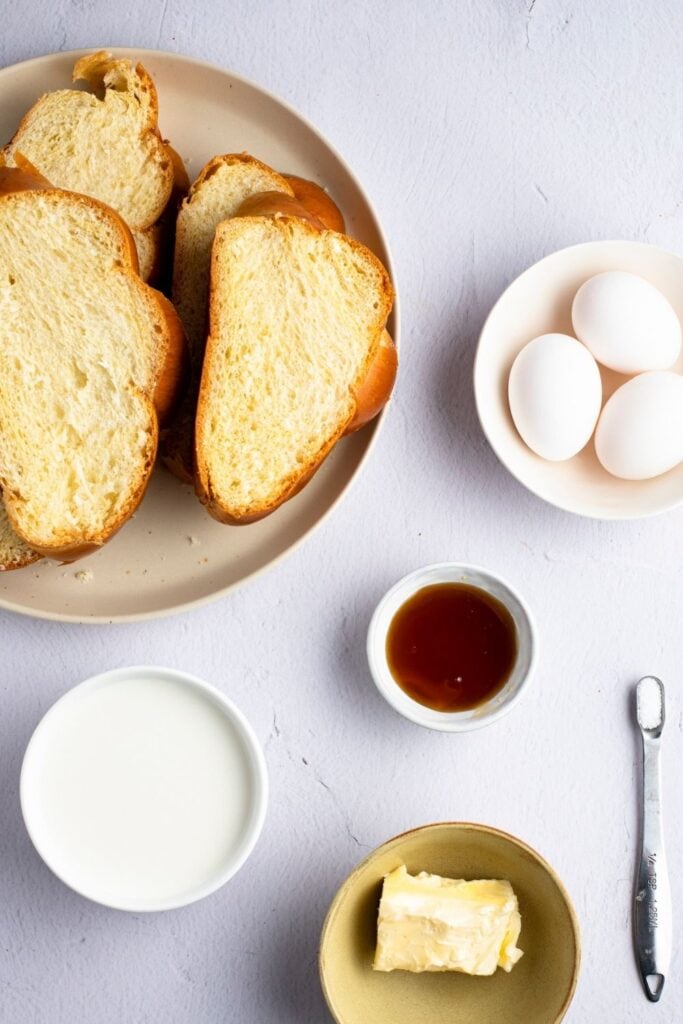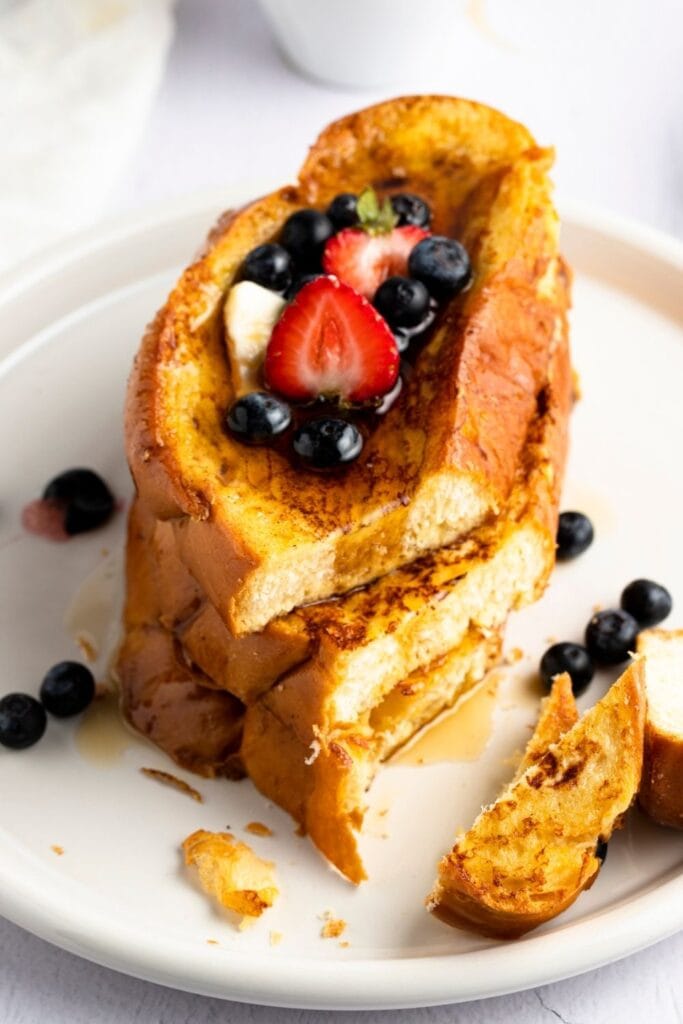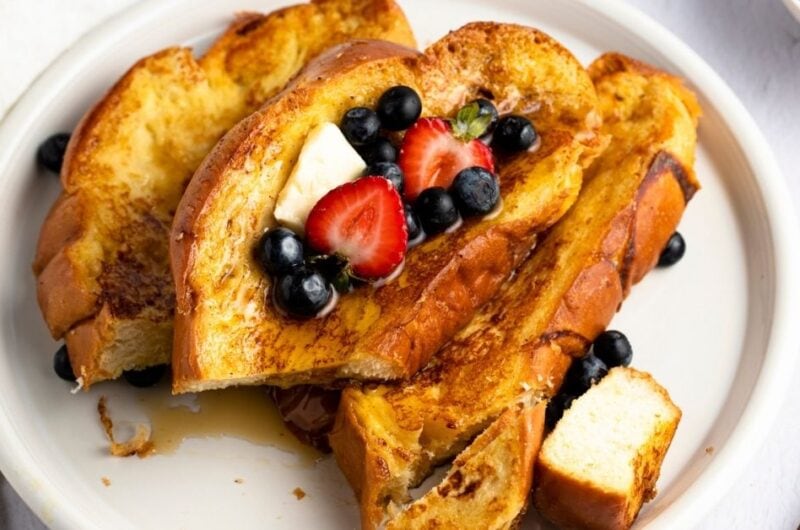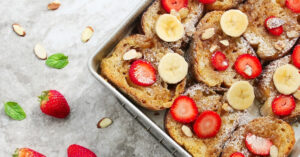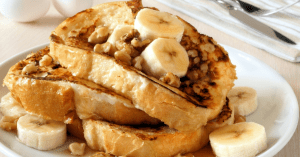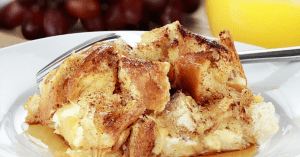Whether you serve it for breakfast, brunch, or even dinner, French toast will never disappoint, especially this version. This French toast has a thin, crispy crust on the outside, and is insanely creamy on the inside. Unlike other recipes, this one has a secret ingredient in the custard that makes the toast even more special. Ready to give breakfast an upgrade? This French toast is calling your name.
Alton Brown French Toast
Alton Brown is famous for his unique approach to cooking. His brilliant ways of educating people about the science behind cooking have earned him much respect and recognition in the culinary world. So when he teaches you how to make French toast, you should listen! This article has all his tips and more to make sure your French toast turns out perfect every time.
How Do You Make Alton Brown French Toast?
Start by slicing the bread into 1/2 to 1 inch-thick slices. Skip this next step if you’re using stale bread. If you’re using fresh bread, you’ll need to pop the slices in the oven for 16 minutes (8 minutes on each side) at 300 degrees Fahrenheit so they’re nice and sturdy. Next, preheat the oven to 375 degrees Fahrenheit. Then, place a cooling rack over a sheet pan. This is where you’ll put the bread slices after soaking them in custard. The sheet pan will catch the custard drippings, ensuring mess-free cooking. Alton Brown’s custard recipe calls for eggs, half-and-half, salt, and a special ingredient – honey. Microwave the honey for 15 seconds so it’s easier to mix. Then, whisk it in a pie pan together with the eggs, and half-and-half, and salt. It’s time to soak the bread. Let the slices sit in the custard for 10 seconds on each side, then transfer them onto the cooling rack. Now, you’re ready to cook it. Melt the butter in a large pan over low heat. Let it warm up to 350 degrees before cooking. Pan-fry the bread slices, two at a time to avoid overcrowding, for 2 to 3 minutes on each side. Place the bread in a baking dish and bake in the middle rack of the oven for 5 minutes. And that’s it, you’re done! Serve your toast with your favorite toppings, and breakfast is served.
The Best Bread for French Toast
The best bread is one with a dense crumb. It should be able to hold its shape even when soaked in custard. Soft bread varieties aren’t sturdy enough and will fall apart after soaking them in the custard. My top choices are brioche, challah, Pullman Loaf, baguette, sourdough, and French bread. If you have tried others and worked great for you, let me know! You’ll want to slice the bread into at least 1/2-inch thick pieces. Any thinner than that, and they’ll disintegrate in the custard. Stale bread is ideal because the drier it is, the better it is at absorbing the custard with it disintegrating. But don’t feel like you’ll need to wait another day before you can make French toast. Here’s a simple technique to make fresh bread French toast-worthy: pop it in the oven. Bake the slices for 8 minutes on each side at 300 degrees Fahrenheit, and they’ll be firm and sturdy.
Why Is My French Toast Soggy?
Good French toast should be crisp on the outside and soft and creamy on the inside. Follow these tips to avoid soggy French toast:
Don’t be afraid to soak the slices. Ten seconds per side seems like a long time for soaking the bread, but don’t worry, it can handle it. If you don’t soak it long enough, it won’t absorb the custard, resulting in a soggy toast. Stick to the bread recommendations above – brioche, challah, Pullman Loaf, baguette, sourdough, and French bread. They’re tried and tested to hold their shape even after soaking them in liquid.
Tips for the Best French Toast
Alton Brown recommends slicing the bread into 1/2-inch slices, but personally, I prefer to make 1-inch thick cuts. This way, the French toast is nice and crisp on the outside, and super creamy on the inside. Bring the eggs and half-and-half to room temperature. This will make it easier for the bread to absorb the custard. If you forget to take them out of the fridge, just submerge them in hot water for about 5 minutes, and they’ll warm right up.Strain the custard before you soak. It’s not required, but it will get rid of those stubborn lumps of egg whites that are impossible to incorporate. Preheat the pan (and butter) before you fry. If the pan isn’t hot enough, the toast will form a scrambled egg-like bottom (called a foot). Want to make French bread ahead of time? You certainly can. Prep the custard the night before and chill it in the fridge. Place the fresh bread slices in the oven overnight – no heat needed. Ovens give off residual heat even when they’re not turned on.
Then, just soak the bread and bake the following day.
Press the slices mildly into the custard so they absorb the liquid well.If you want your toast even richer, use heavy cream instead of half-and-half.Topping suggestions:Classic: You can’t go wrong with whipped cream and maple syrup. Chocolate Madness: Sprinkle with chocolate chips and drizzle with chocolate syrup or fudge.Nuts for Nuts: Add a splash of almond extract to the custard and garnish the toast with chopped toasted nuts, walnuts, or almonds.Dessert for Breakfast: Smother the toast slices with cream cheese spread and top with berry compote or jam. It’s instant cheesecake, for the win!Fruity French Toast: Top the slices with fresh seasonal fruits and berries.French Toast a la Elvis: Peanut butter, banana slices, bacon, and maple syrup. Savory French Toast: Serve slices with ham, bacon, and/or sausage.
More French Toast Recipes You’ll Love
Baileys French ToastPaula Deen French ToastCracker Barrel French ToastBrioche French Toast Click on a star to rate it!
Average rating 4.8 / 5. Vote count: 5 No votes so far! Be the first to rate this post.
Share on social media: Let us improve this post!




